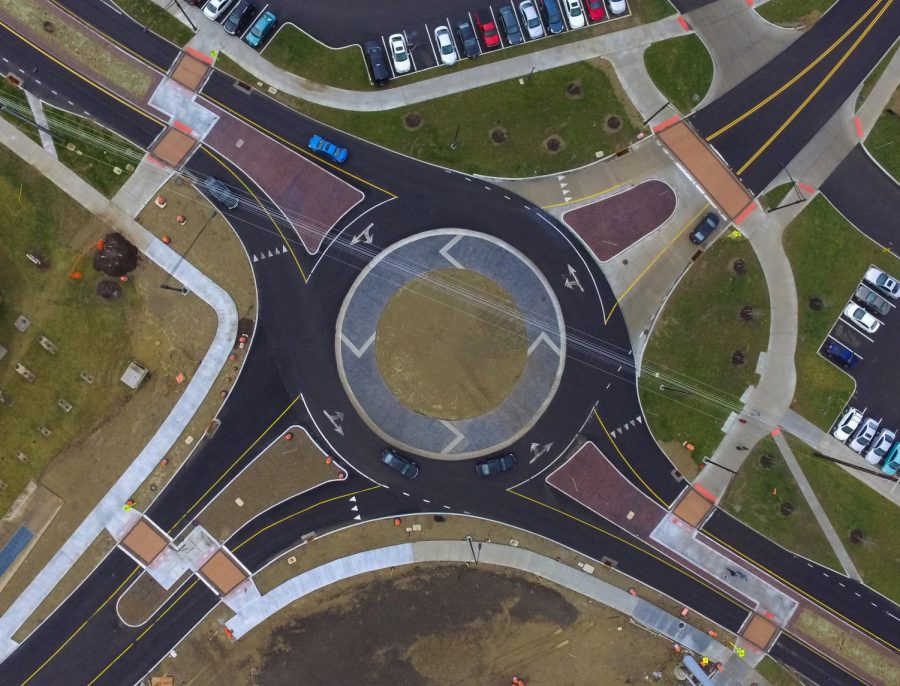Students express safety concerns of new roundabout
January 24, 2017
Kent State students expressed concerns about the newly constructed roundabout on Summit Street, whether they are driving through, or crossing to and from the Student Recreation and Wellness Center.
“If (students) are cautious, I think roundabouts are fine,” Alison Scalfano, a junior special education major, said. “But I think college students just kind of drive — they don’t even look or think first.”
Pedestrians are not the only ones who expressed concerns with the roundabout. Drivers expressed uncertainty about how to navigate roundabouts as well.
Maria Peck, a sophomore nursing major, frequents the area and noted that the roundabout is not the issue, but rather the students themselves.
“Wherever college kids are, driving or walking, they are just going to be a little careless,” Peck said. “I don’t think the roundabout has anything to do with it.”
Anne Dargenio, a sophomore fine arts major, felt strongly about the congestion caused by the traffic circle and didn’t see too many benefits of it.
“I hate it, nobody knows when to go or not,” Dargenio said. “Students and cars just wait around trying to figure out who should go.”
Dargenio said while she was on a recent PARTA bus trip during rush hour, she didn’t feel the roundabout helped with traffic jams.
“I was on the bus forever because the roundabout was packed with people who don’t know what to do,” Dargenio said. “It’s been a disaster.”
According to Michael Bruder, the executive director of Facilities, Planning and Design at Kent State, uncertainty regarding traffic circles can be beneficial to drivers.
“The fact that some people are uncertain about a roundabout makes them safer,” Bruder said. “They will slow down, make eye contact with other drivers and pedestrians and pay attention more.”
Bruder and his department collaborated with the city of Kent while constructing Summit Street and helped ensure the safety of students, as well as other pedestrians visiting the campus.
“Ultimately, it was the city’s project through the Ohio Department of Transportation, but the university was a really strong partner with the city of Kent on the design,” Bruder said. “That intersection was an important area of study.”
Bruder said the city and the university decided to go with a roundabout primarily to increase safety.
According to a study done by the American Association of State Highway and Transportation Officials (AASHTO), “roundabouts reduce the types of crashes where people are seriously hurt or killed by 78-82 percent when compared to conventional stop-controlled and signalized intersections.”
Bruder said even though traffic circles are safer than a regular intersection, accidents still happen. However, since cars must travel slower through a roundabout, the accidents are less serious.
According to Insurance Institute for Highway Safety (IIHS), the more familiar drivers became with roundabouts, the less they opposed them. Their study showed that “53 percent opposed the roundabouts before they were built. That dropped to 44 percent six months after construction and 27 percent one year later.”
Dargenio and Peck both said that having more education about traffic circles would help both safety and efficiency.
“If people would learn how to (navigate roundabouts) I wouldn’t be so mad about this,” Dargenio said. “I think the more they know the better the traffic will flow and the safer students will be.”
For students who may have never encountered a roundabout before, or who are uneasy about the rules, the university developed a website with tips and a video on how to navigate roundabouts. The video has instructions for drivers, pedestrians and bikers.
“Statistically, (roundabouts) are safer than a standard intersection, both for pedestrians and vehicles,” Bruder said. “As a pedestrian, you are only crossing one lane of traffic at a time, so you only have to look for an opening from one direction. Cars are also traveling at a lower speed in (roundabouts).”
Sarah Heber is the safety reporter, contact her at [email protected].

























